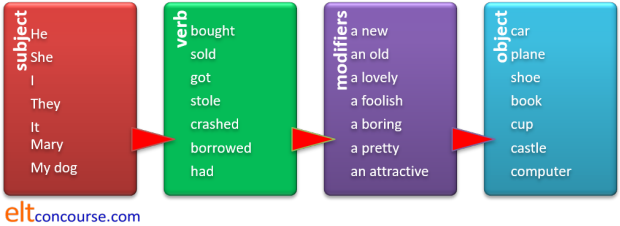Lexicogrammar: the interface

There is a noticeable tendency in language teaching to treat
meaning and structure as if they were self-contained areas of
knowledge about language.
It is, however, fairly clear that, for example, the distinction
between these two sets of sentences:
- I am feeling ill
- I feel ill
- I am living in Paris
- I live in Paris
is not simply one of whether the speaker chooses to use a
progressive aspect of the verb.
Sentences 1. and 2. are, for most purposes, synonymous and it makes
little difference whether the speaker chooses to use the verb
dynamically, as in 1., or statively, as in 2.
However, sentences 3. and 4. are different in meaning as well as
structure. Sentence 3. implies a temporary condition but
sentence 4. implies a permanent one.
The essence of the difference lies not in the grammar, which is
common to both pairs, but in the meanings of the verbs.
Put another way, the grammar and the meaning of words are not
separate systems treatable as discrete units but are interdependent.
That, roughly speaking, was what Halliday meant when he coined the
term lexicogrammar to describe the language system. In his
words:
grammar and vocabulary are not different
strata; they are the two poles of a single continuum, properly
called lexicogrammar
Halliday / Matthiessen (2014: 24)
This guide is a short one, focusing on some obvious but important examples of times in which it is unwise to treat the systems of the language as if they were either grammar or lexis (i.e., structure or meaning carrying items) but to consider both systems together. Before we do that, it is necessary to take a short diversion into understanding our terms.
 |
Syntax and lexis |
If we choose to separate the systems for the sake of argument, we
can, of course do so and consider syntax as separate from paradigm.
There are two types of relationship at work here:
- Syntagmatic relationship
- This describes the relationship which work horizontally between words. Subjects use Verbs, Verbs sometimes take Objects, Adjectives modify Nouns, Adverbs modify Verbs and so on. The relationship is to do with syntax (from the Greek meaning to arrange together).
- Paradigmatic relationships
- Relationships work vertically in the sense that Noun
phrases can be replaced by other Noun phrases, Verb phrases by other
Verb phrases, Adjectives by other Adjectives, Adverbs by other
Adverbs and so on. The relationship is to do with word
and phrase class. The word paradigmatic derives from
paradigm (from the Greek meaning to show
side by side).
It works like this:

Each slot in the sentence can be replaced by words and phrases in the same classes to make new sentences (some of which might make sense) virtually ad infinitum. The boxes give examples of items in a paradigmatic relationship; the red arrows show the syntagmatic relationships.
For many purposes in the classroom, it makes some sense to analyse language this way and separate out considerations of syntax from considerations of lexical relationships and word and phrase class.
However, the purpose of this guide is to explain why syntactical
arrangements alone do not explain the systems of a language and
lexical relationships alone also cannot do so.
In order to do that, we'll take some examples of where the interface
between grammar and meaning provides some insights.
 |
Oh, that's just an exception |
There is a temptation, worth avoiding in the classroom, to
suggest that anything which appears to break a syntactical rule
qualifies as an exception and needs to be learnt separately.
So, for example, we might suggest that a syntactical rule is
exemplified by allowing, e.g.:
She walked to work
but forbidding
*She walked the way to work
and stating that the rule is that this verb is, in English,
intransitive. So far, so good and so simple. However,
when learners then encounter:
We walked the dogs
I walked her to the door
I walked an hour
They walked three miles
it is not terribly helpful to tell them that these are merely
exceptions to the rule. What we have, in fact, is an example
of something which happens frequently in all languages:
meaning has altered what is syntactically possible.
What has happened is that our syntactical rule has been refined to
take semantic issues into account and is now:
- When walk means go on foot it is intransitive.
- When walk means exercise or take for a short journey on foot it is transitive.
- When walk mean accompany, it is transitive.
- The verb can be used with distances and times as direct objects.
and the issue is solved by appealing to meaning, not syntax.
Exemplification follows of some of the key areas in English where semantic considerations work with (not against) syntactical issues to refine the rules of usage.
 |
The article system |
A particular source of confusion for learners from many language
backgrounds is the article system in English which compels speakers
to consider a range of factors which they may not have to think
about in their own languages including specificity, definiteness and
countability before deciding on the correct article to use. We
get from these considerations a rule which states that abstract
ideas take a zero article (Ø) because the reference is non-specific,
non-definite and uncountable. Thus it is that we can have:
I don't approve of prejudice
She was in danger
and not
*I don't approve of a prejudice
*She was in a danger
or
*I don't approve of the prejudice
*She was in the danger
and all works well until we encounter, e.g.:
The prejudice against women is unacceptable
A prejudice he still has is to assume all politicians are
lying
There is a danger of it breaking
The danger is clear
which appear to break the rule and must, therefore, be treated
as exceptions and separately learned.
A little thought, however, reveals that the issue is not
syntactical, it is semantic. Many mass nouns describing
abstract concepts can:
- be used both as mass nouns and as count nouns so we get,
e.g.:
The friendships she has are important to her
The sorrows of the family were many
It is a pet hate of mine
and so on. - be modified to move the concept from a generic, non-specific
meaning to a definite and specific reference so we can also
have:
He is one of the loves of her life
Dinner was a real delight
The dangers inherent in the process are clear
(This small semantic issue also explains, incidentally, why we have:
The United States
and not
*The America)
No rule is being broken in these cases because the meaning of the nouns has altered to allow the general syntactical rules for article use to be followed.
The alternative to labelling some uses of the article system in
English as exceptions to the rules is to invent an unnecessary rule
to explain certain uses. We get, then:
She bought a new flat. The flat was on
the second floor.
explained by the invention of the known-unknown rule which
states that the unknown instance is preceded by the indefinite
article and a known reference by the definite article.
However, semantic considerations can be used to make this clear
without enjoining learners to acquire a new rule.
When the reference is indefinite but specific, the use of the
indefinite article is customary so we can explain:
A man called while you were out
and
A letter has arrived for you
by invoking the meaning intended that I know what
sort of thing I am referring to (so references are specific to
man and letter) but not exactly which
thing is in question (so the references are indefinite).
When the reference is to something both specific and
definite, the rule is to use the definite article (because we know
both what it is and which it is). This explains:
The bathroom is upstairs
because we know we are referring to a specific and definite
room. Of course, if we said:
A bathroom is upstairs
it would be clear that we are now referring to one bathroom
from a possible number of them and that would be specific reference
to a bathroom but indefinite reference to which bathroom and no rule
is broken.
If we apply that rule to the first example, it is clear that the
first reference to flat is specific (we know what it is)
but indefinite (we don't know which it is). The second
reference is, because of the meaning, not the
grammar, to something which is both specific (we know what it is)
and definite (we now know which it is: her new flat) so we
follow the usual rule and use the definite article for specific,
definite reference. The issue is, therefore, solved by
applying the rules and considering the meaning of
what is said rather than by inventing a new rule to explain it.
The guide to the article system in English, linked below, contains more consideration of semantic issues which, when ignored, lead to the invention of new rules and the invocation of exceptionality to explain what is actually a tightly rule-bound, lexicogrammatical system albeit one profoundly affected by meaning.
 |
The passive voice |
The system explained above is the traditional way of viewing the systems of a language
and in many cases it does make sense to separate them and teach,
say, the formation of passive-voice clauses as if it
were possible to analyse them without reference to the words and
meanings embedded in them.
Therefore, we can, taking a purely syntactical approach suggest
that:
The man drove the car
and
The car was driven by the man
describe the same proposition.
It's a short step from there to stating a rule that an active-voice
clause with a transitive verb taking a single object can be
transformed into a passive-voice equivalent.
Thus, it follows that we can present learners with, for example:
| Active | → | Passive |
| The children broke the plates | → | The plates were broken by the children |
| The car damaged the fence | → | The fence was damaged by the car |
| She will do the work | → | The work will be done by her |
and so on, quite literally, ad infinitum.
However, if we take that approach, we will soon run into trouble and
be forced to explain that although something like:
Her daughter resembles her
is a well-formed active-voice clause with a discernible subject, a
transitive verb and an object as one would expect, so we can,
following the rules of syntax make:
*She is resembled by her daughter
and arrive at a perfectly formed (and just about understandable) clause
which is nevertheless disallowed in English. The reason it is
disallowed is not that it is a syntactical or grammatical exception,
it is to do with the meaning of the verb itself.
What we have to do is look at the meaning of transitive verbs and
the relationships they have to their objects.
Here's what is meant:
Most transitive verbs imply that the subject of the clause is acting
on the object and so it is that we can make acceptable passive forms
from, for example:
John kicked the ball → The ball was
kicked
Mary told a joke → The joke was told
The storm damaged the house → The house was damaged
and thousands more clauses containing transitive verbs in which the
object is altered or acted on by the subject.
However, if we consider, for example:
She has a lot of money
They possess four houses
The chair lacks a leg
The tank contains 45 litres
The bottle holds a gallon
This shirt fits me
The boy took after his father
then it is clear that the subject of the verb is not acting on
the object in the same way that the subjects act in the first set of
three examples.
What these verbs do is express a relationship between the subject
and the object rather than signalling that the object is affected,
changed or acted on by the subject and that is the reason that they
do not form passive clauses. We cannot have:
*A lot of money is had by her
*Four houses are possessed by them
*A leg is lacked by the chair
and so on.
So our rule for how to form the passive in English has to be revised
to include the meanings of the verbs, not just their syntactical
relationships with other elements in the clause.
 |
Relative pronoun clauses |
Relative pronoun clauses might, at first sight, be the subject of
syntactical issues alone because considerations of whether or not
that can be used, whether or not the pronoun may be omitted
and whether or not the clause can be reduced by ellipting the
pronoun and the verb seem to be solely syntactical issues to do with
case and tense forms.
They are, however, also subject to issues to do with the language
user's intentions and the meanings which are expressed in a number
of ways:
- English distinguishes between defining and non-defining (or
restrictive and non-restrictive or identifying or
non-identifying, as you prefer) relative clauses and the type of
clause has a syntactical effect on how they may be constructed
(with or without the ellipsis of the pronoun or allowing the use
of that etc.).
However, the choice of clause type is not defined grammatically, it is determined by the meaning that the language signals.
We cannot allow:
*The United States President who is here at the moment will speak later
because we cannot define that which is unique so, in English (but not in other languages for the most part), we have to select a non-defining structure and mark it by punctuation or tone group prosody allowing only:
The United States President, || who is here at the moment, || will speak later.
In other words, the nature of the subject of the clauses determines the type of clause we are allowed and that is a meaning issue. Any uniquely identifiable subject is disallowed in a defining relative clause and that will include people (identified by name or position), places (identified by name, such as France, Germany, Asia, Mars etc.) and so on.
Therefore, we cannot allow, for example:
*Germany which is the richest country in Europe || is much admired
or
*Number 10 Downing Street which is in the centre of London || is well known
and can only have:
Germany, || which is the richest country in Europe, || is much admired
or
Number 10 Downing Street, || which is in the centre of London || is well known
The effect of this is to allow a certain ambiguity (another meaning rather than syntactical issue) to creep in so we may encounter, for example:
The president of the company that is very successful
which could refer to a successful company or a successful president and has to be disambiguated by selecting the appropriate pronoun rather than that and having either:
The president of the company which is very successful
or
The president of the company who is very successful
and that is how the meaning the speaker wishes to signal determines the syntax. - The choice of pronoun in English is heavily dependent on
both the type of noun referent and the case of that noun.
That is to say, issues of both meaning
and syntactical role are in play.
We find, obviously, that who and whom are used to refer to people and the latter is accusative only. There are, however, some more subtle relationships to do with the meaning of the referent that are seen:- The pronoun which may be applied to people but
only if the person in question is unknown to the speaker so
we can allow:
The police officer which arrested her made his report
but we do not allow
*My local police officer which arrested her made his report
and the difference is purely to do with the relationship between the speaker and the subject of the clauses. - Similarly, the pronouns which
and who(m) may both be applied to collectives of
people so we can allow both:
That's the committee which decided
and
That's the committee who decided
and the choice will often depend on how well the people in the group are known to the speaker.
However, immediately, there is a knock-on syntactical effect because, in BrE at least, the verb and pronoun concord will be altered so we get:
That's the committee which decided the issue and it presents its report later
vs.:
That's the committee who decided and they present their report later
and that is an example of meaning altering syntax rather than syntax being determined by grammatical relationships alone. - An allied issue is that the pronoun who can be
used to refer to some higher animals but only to ones with
which we are acquainted so we can state:
My dog, who hardly barks at all, is a much loved family pet
but we cannot state:
*A dog, who barked all night, lives somewhere close, I think
and we are forced to select which or that as the pronoun.
- The pronoun which may be applied to people but
only if the person in question is unknown to the speaker so
we can allow:
- We can reduce a relative clause from, for example:
He lives in the house which was built by his brother
to
He lives in the house built by his brother
without recourse to worrying about the meaning because this is a syntactical issue subject to discernible structural rules which can be set out in a paragraph or two (as is done in the guide to the area, linked below).
There are, however, two issues to do with meaning which come into play to determine whether a reduced clause is permissible (or to be recommended):- Time and tense:
We cannot reduce a sentence such as
He lives in the house which has been built by his brother
to
He lives in the house built by his brother
because we lose the perfect aspect of the verb and send a different signal.
We can also not reduce:
He is going to live in the house which will have been built by his brother
to
He is going to live in the house built by his brother
because the sense of the proposition is not maintained and the second sentences implies that the house is already completed but the first makes it clear that it is not. - The nature of the subject:
If the subject of both clauses is the same, i.e., they are co-referential, then only a non-defining clause can be used so while we can allow:
The woman who is a gardening expert will be here later to help
in which we define the woman, as one among many, we cannot reduce that to:
*The women a gardening expert will be here later to help
because we know that the woman and a gardening expert are the same entity and we cannot define the same thing twice. We have, therefore, to make the clause non-defining and only allow:
The woman, a gardening expert, will be here later to help
Issues of co-reference are to do with meaning, not syntax.
- Time and tense:
All of these issues (and more are considered in the full guide to the area) are to do with the meaning we wish to achieve and are not, fundamentally, syntactical issues at all.
 |
Adjuncts |
Part of the definition of an adjunct is that it is extra
information, often concerning the verb phrase, which is not essential to the clause and
can be safely omitted without damaging the syntax and acceptability
of the clause.
We get, therefore:
She left in the morning
That day, she left
He walked over the hill and down the lane to my house to see
me
and in all of those we have adverbial adjuncts adding information to the verb
phrase which can be omitted (albeit, of course, with a loss of
information) so we can equally have:
She left
He walked
and, because the verbs are intransitive, a two-word clause is well formed.
The same effect will work with transitive verbs although the object
must be retained unless they are ambivalent (like, e.g., eat):
She painted the house yesterday in the
sunshine
They opened the box very carefully and slowly to see what it
contained
Last week he timetabled the meeting later than usual to allow
people to arrive
and they can all be well-formed without the adjuncts as:
She painted the house
They opened the box
He timetabled the meeting
although, again, information is lost.
However, if we try this trick with some other verbs which have a
different sort of meaning, we encounter a problem. To see what
it is, try removing the prepositional phrases from:
He put the box in the corner
He placed the lamp in the corner
He rested the rock on the edge of the wall
We ventured further into the cave
She stayed in a hotel by the river
and then we get the unacceptable:
*He put the box
*He placed the lamp
*He rested the rock
*We ventured
*She stayed (unless the meaning is remain
rather than reside)
and there is, now, a need to consider meaning as well as syntax
to get to the root of the issue.
Again, as we saw with the formation of passive clauses it is the
relationship which the verb signals that matters.
If, as in these examples, the verb expresses a sense of positioning
something (either oneself or another entity), then the place adjunct
is compulsory, not optional.
Verbs that do this include keep, lay, place, plonk, position,
put, rest, set, site, situate, stick, stuff.
and they are described as PP complement verbs.
The issue is, of course, semantic, not syntactical and to get the
structure right, we have to know that the prepositional phrases are
not adjuncts at all and that is a matter determined by the meanings
of the verbs.
PP complement verbs are, therefore, not exceptions to the rules, they are part of the rules.
 |
Tense and aspect |
A good example of the relationship between meaning and structure concerns the use in English of the perfect aspect of the verb combined with a progressive form as in, for example:
- She has been working really hard recently and needs a break
- They had been waiting for the train for hours and were frozen stiff
and in both cases, we can see that the effect of the aspects is twofold:
- The progressive form emphasises the
duration of the event
and - The perfect form serves to embed one event in a second event which it alters or enables in some way
Despite the fact that many languages do not do this kind of thing
at all, the sense of the aspects in English is learnable and
teachable.
However, again, when we use different verbs which carry different
sorts of meaning, it becomes clear that there's a problem with
simple explanations. Consider:
- Someone has been stealing vegetables from my garden
- She had been switching the heating off and on and the house got colder
Although the structures (i.e., the syntax) of sentences 1. and a. and 2. and b. are parallel, it is clear that the meaning is not.
The issue here is to do with what are called punctual or
momentary and durative verb senses.
Some verbs, such as live, work, stay,
study, read and a host more can be perceived as taking
up a time frame of some measurable length. For this reason, we
allow:
She has been living here for years
She has been working on the problem this week
I have been staying at The Ritz
They had been studying French at university
I had been reading Goethe lately
Other verbs cannot be used in the same sense and so the aspect which
the syntax of the verb phrase signals is very different:
He has been hitting it with a hammer
They have been arriving late most mornings
The light had been flashing
She has been tapping at the laptop keys
I had been upsetting my neighbours by parking there
and in all these cases, the sense is not of a progressive
action, it is of a repeated or iterative action.
Certain verbs, referred to as telic (i.e., starting and finishing
almost simultaneously) in sense, cannot successfully be used with
progressive aspects at all because they produce rare or odd forms
such as:
*They were popping the champagne cork
*"That's my little success," he was quipping
and so on.
To be clear, this is not a distinction between stative and
dynamic uses of the verbs (that comes next), it is dependent on the
meaning of the verbs alone.
Punctual verbs, for your reference, include at least: arrive,
bang, begin, break, bump, burst, chop, crash, detonate, dip, dive,
drop, explode, flash, glow, hit, jolt, kick, light, meet, name,
open, pop, quip, rap, shatter, shoot, slam, smash, spit, spurt,
steal, stop, tap, thump, upset, volunteer, wake.
With those verbs, a progressive form signals a repeated short
action, not a durative one. In some cases, moreover, an action
cannot be repeated at all (they are telic in the real sense) and the
progressive form is, therefore, not even allowed so for example:
*I had been waking my sister
*They have been naming their child
*When I dropped it, the glass was shattering
*The bomb was detonating
are all malformed, not because they are syntactically flawed but
because they are semantically flawed.
Again, the meanings of the verbs do not lead to exceptions to the aspect rules of English, they are part of the rules.
 |
Stative and dynamic use |
It is often averred that some verbs are always used statively and others in a dynamic sense so we get lists such as:
- Verbs of possession or relations between things
be, appear, consist, contain, cost, have, depend, fit, include, involve, matter, mean, measure, owe, own, possess, seem, weigh - Verbs of sensations
feel, hear, look, see, smell, sound, taste, touch - Verbs referring to emotional states
adore, appreciate, care, desire, dislike, hate, hope, like, love, mind, need, prefer, value, want, wish - Verbs referring to mental processes and states
agree, astonish, believe, concern, deny, disagree, doubt, expect, flabbergast, forget, imagine, impress, know, please, promise, realise, recognise, remember, satisfy, suppose, surprise, think, understand
There is no denying that many of these
verbs do occur much more frequently in simple tense forms than in
progressive ones. On the other hand, a few, such as
measure, are actually more frequently used dynamically.
Of the others, most are used both statively and dynamically with,
often, a shift in meaning and syntax is not independent of meaning.
Almost all these so-called stative verbs can be used dynamically and
it all depends on what the user of the language means and we can
take examples from the same four categories to show this:
- She is appearing in the play
They are having trouble with their son - She is not feeling well
The engine's sounding a bit rough - She was hoping for better weather
They are wishing her happy birthday later - She is denying all charges
I was forgetting all about the need to book a table
It is, in other words, rare to discover a verb in the lists above
which cannot be used dynamically and all of them take progressive
forms in non-finite clauses so we routinely allow:
Containing only four grams, the bottle is
tiny
Depending how he feels, he'll be here later, I expect
Seeing everyone's already here, let's start
Tasting the soup again, the chef pronounced it ready
Caring little for long walks, I stayed at home
Needing some supplies, we went to the supermarket
Realising the danger, they backed away from the edge
Understanding his difficulty, we didn't press the matter
It is probably clear by now that simply labelling verbs as stative or dynamic is an inadequate and potentially harmful approach to take because it ignores meaning.
 |
Adjectives |
| two old friends |
When asked for a rule of thumb to explain what adjectives do in
English it is simple to say something like they describe or
modify a following or preceding noun or noun phrase
and that works well until we encounter times when they don't
(really).
By some estimates, around 40,000 words in English qualify as
adjectives and the majority of them are unproblematic for learners.
If you are reading this somewhat esoteric guide, you will probably
be aware that we can say:
The woman was young
and
She was a young woman
and there is little to tell between those two propositions so most
adjectives can be used predicatively or attributively (as they are
respectively in these examples).
If we leave it at that, we have a reasonably good rule for the
syntax of adjective use which will hold up well for thousands of
adjectives.
However, the in-service guide to adjectives on this site is a long
one and that betrays the fact that all is not so simple.
 |
Inherent vs. non-inherent uses |
While it is possible to say, for example:
My friend is old
which will mean that he or she is somewhat advanced in years, when
we use the adjective attributively as in:
She's an old friend
we are confronted by the fact that the adjective now describes the
friendship rather than the friend. The fact that the word
friendship does not appear in the clause at all is somewhat
confusing if we are taking a purely grammatical approach and
focusing on word order and syntax.
We have, therefore, to take a semantic tool to the mechanism and see
why this is happening. To do that, we have to consider what is
an alienable or inalienable characteristics of the noun we are
considering. That is to say, are the characteristics we wish
to describe related to the noun or part of the noun itself?
For example, if we say:
That woman is small
we are referring to an inalienable, inherent quality of the woman and we can
also phrase that as:
She is a small woman
so both types of syntax are available to us.
Another way of saying this is that the characteristic of smallness
is inherent in the noun and in neither case is the woman's size
subject to her or anyone else's will.
However, when it comes to alienable qualities, the case is
altered so if we say:
She is a small businesswoman
using the adjective predicatively, we find that the reference now is
to the type of business the woman runs rather than the woman
herself.
Even attributively with:
The small businesswoman at the back asked a question
we are constrained to understand that it is the business to which
the adjective refers, although attributive use can produce some
ambiguity.
The rule, such as it is, is semantic not syntactical and, briefly states:
Any adjective which cannot apply to a relationship will automatically be understood as referring to an inherent property of the noun
That means, for example
My friend is tall
can only be applied to the person because tall cannot be
used (because of its meaning) to modify a relationship.
Other adjectives which have to be considered semantically rather
than syntactically include: close, long-standing, nodding, good, intimate,
distant, old, bitter, devoted, great and more.
So, for example:
They are bitter enemies
will be seen to apply to the
enmity not the people
She's a distant cousin
will be seen to apply to the
kinship not the person
She's a long-standing member of staff
will be seen to apply to the employment, not to the person
and so on.
Another semantic issue concerns the adjectives new, old,
young and elderly which can be variably applied
depending on the intended meaning and no syntactical rule is
available to help us out so:
She's a new colleague
will be taken to refer to the relationship not the person, but
She's a young colleague
will be taken to refer to the person not the relationship, and
He's an old friend
can only refer to the relationship, but:
He's an elderly friend
can only refer to the person.
This is not, lest we get carried away into the stratosphere of a lexical approach, a question of collocation. It is an issue with meaning.
 |
Dynamic vs. stative use |
While we can have, as we saw above, both:
She's a young girl
and
The girl is young
further semantic issues arise from the meaning of the adjectives we
use and the message we want to send.
If we wish to imply that the characteristic is under the control
of the person (or thing) in question then we are forced to employ
the predicative word ordering. We get, therefore:
The police officer was patient
and that strongly implies that she may have become impatient at any
moment.
However, if we say:
The patient police officer talked to the men
the implication is that the officer was always patient and not just
at that time.
This phenomenon also affects imperative uses of adjectives, so,
while we can accept:
Don't be angry
because we understand that being angry or not is a factor which
the hearer can control, we cannot accept:
*Don't be English
because one's nationality is a state not a factor under the
personal control.
The same phenomenon also affects whether a verb may be used
progressively or statively so there is clearly a distinction
between, e.g.:
John was being interesting
and
John is an interesting man
The rule is that stative adjective use can be both predicative and attributive but dynamic adjective use demands only the predicative form.
And this is, of course, a semantic rule which determines a syntactical event.
 |
Proleptic use |
The general rule is, as you know, that adverbs modify verb
phrases and adjectives noun phrases so we get:
Work slowly
and
The work was slow / It was slow work
This is, naturally, a purely syntactical rule to do with examining
the structure of the sentence or clause and determining what word
class is
being modified and then selecting the correct word class to fill the
slot in the clause. There is no difficulty filling slots such
as:
Mary was driving __________
and
Mary is a __________ driver.
However, here are some examples in which the rule appears to
break down:
Hammer it flat
Make it wet
Play it loud
Pull it straight
Roll it smooth
Pull it tight
and in all these cases we have a simple imperative clause with a
transitive verb and a pronoun object. The syntactical rule
should allow only an adverb to fill the slot but the sentences are
all well formed.
The solution lies in meaning, as usual. The adjectives here
are not being applied to the verbs (because that is disallowed by
the rules of English syntax) but to the objects of the verbs which,
in this case, are pronouns but could be nouns so we can have:
Hammer the iron flat
Make the paper wet
Play the music loud
Pull the cloth straight
Roll the pastry smooth
Pull the rope tight
Meaning, not syntax, rules.
 |
Transitivity |
It is a fairly simple matter to divide verbs in English into those that:
- Intransitive verbs:
which never take an object such as: go, come, arrive, cough, happen and a few hundred more and form clauses such as:
She arrived at the hotel
but not
*She arrived the hotel - Ambivalent verbs:
which may take an object or not such as: break, close, drive, finish, eat, smoke and hundreds more and form clauses such as:
We ate late
and
We ate lunch - Transitive verbs:
which are those that must take an object such as: believe, consider, lose, receive, take and hundreds more and form clauses such as:
I lost my wallet
but not
*I lost - Ditransitive verbs:
which are those that can take both a direct and an indirect object such as: ask, give, hand, tell, offer, pay, promise and a few hundred more (probably) which form clauses such as:
They gave the money
They gave me the money
They gave the money to me
but not
*They gave
and the rules we apply to the verbs are all syntactical to do with where we place the objects (if they are permitted) and what order they come in.
However, a glance at the following examples will show that there are also lexical, semantic rules in action here, too.
- He considered the issue
He considered her a fool - The chair broke
She broke the chair - He read a book
He read them a story - She called at seven
She called her father - She built me a house
She built a house for me
She brought me a shirt
She brought a shirt to me
Here are some notes:
- The first of these examples concerns the meaning of the verb
consider. If it means think about, then
it is monotransitive and conforms to the usual rules.
However, if it means deem or regard, the two
objects become co-referential and the verb takes an object
complement.
The syntax is altered to take account of the meaning. - Here we have a case of the appropriacy of the subject.
If the subject is animate (or at least active) and acts upon the
object, the verb is transitive and must take an
object.
If, on the other hand, the subject is inanimate, the verb is intransitive and cannot take an object while retaining the same meaning.
In the second case, the verb means damage seriously and in the first, it means become unusable.
In the second sense, too, we have what is called an ergative form. The ostensible, semantic object of the verb is, in fact, the chair but the ergative use raises it to the syntactical subject. - With this pair the focus falls on the meaning of read. When it means speak aloud, the verb can be ditransitive or monotransitive but when it takes its usual meaning, the verb is stubbornly monotransitive. The syntax, again, has to be altered to take account of meaning.
- The verb call means either visit (in which case it is intransitive) but when it means telephone it is transitive or intransitive. Moreover, when it is used transitively, it can only mean telephone.
- This is a clear case of a ditransitive use of the verbs but,
unfortunately, the dative shift with build only works
with the preposition for and not with the usual one, to. So
we allow:
She built a house for me
but not
*She built a house to me
The verb bring is more forgiving and allows both formulations.
The reason lies in the meaning, as usual. When the indirect object is the beneficiary, the usual choice falls on for but when the indirect object is the recipient, the choice usually falls on to.
The verb bring can imply either a recipient or a beneficiary and that is why both pronouns are allowable with the dative shift so we can have:
She brought a shirt to me
with the indirect object as the recipient
or
She brought a shirt for me
with the indirect object as the beneficiary
Hence, too, we have, for example:
She sent me the letter
She sent the letter to me
because the indirect object is the recipient but we can also allow:
She cooked me a meal
She cooked a meal for me
because the indirect object is the beneficiary.
That's rather subtle but a question of meaning not syntax.
Other verbs depend heavily on meaning for syntactical accuracy.
For example, speak and talk can be intransitive
(when they mean say aloud or exchange information and
ideas) but say and tell are never
intransitive. The verb tell, when it means inform
is transitive and can be ditransitive but does not allow the dative
shift at all because the meaning does not concern the indirect
object, it concerns the information so:
He told me the train was delayed
is not convertible to
*He told the train was delayed to me
However, when it concerns the act of communicating rather than
informing, the dative shift is allowed
She told a lie to her boss
So, because the sense of the verb has shifted, so the syntax shifts
to follow.
The other notable feature is when the direct object of tell
is a nominalised clause, an indirect object is required because the
meaning of the verb is inform and that verb is, by nature,
transitive.
We allow:
She told me when the meeting started
but not:
*She told when the meeting started
and the syntax is under the control of the lexis.
| All the issues covered above appear in the guides to the relevant areas but here they are brought together. For more, try: | |
| passive voice clauses | for more consideration of the constraints on passive voice structures |
| relative pronoun clauses | for some consideration of both meaning and syntax with these forms |
| place adjuncts | for a little more on PP complement verbs |
| tense and aspect | for lots more on the uses of aspects in English |
| stative vs. dynamic uses | for more on verb types in this regard |
| adjectives | for the in-service guide to the area |
| the article system | for the in-service guide to the area |
| verb types and clause structures | for a good deal more on clause structures and verb meanings |
Reference:
Halliday, MAK, 2014, Halliday's Introduction to Functional
Grammar, 4th Edition, revised by Matthiessen, C, Routledge:
Abingdon, Oxon
